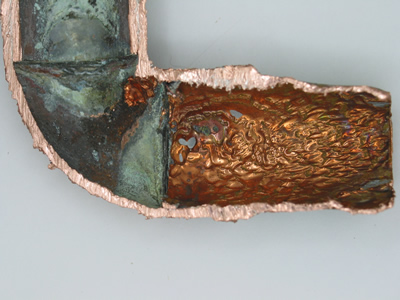Copper tube and fittings have a remarkable track record for plumbing use. The ancient Egyptians are known to have used copper pipes for transporting water and, in modern times, copper tube has been used for over 75 years for plumbing in the U.S. It's a fact that the majority of problems with a copper piping installation can be prevented by proper design and installation practices. It's also true that a major cause of difficulty is erosion corrosion, a mechanically induced failure, which may be caused by number of conditions:
-
Lack of reaming of the tube ends.
Burrs left on the inside of the tube can cause interruption of smooth flow resulting in localized high water velocity and cavitation. Immediately downstream of the unreamed tube end local flow pressure will be drastically reduced, allowing air bubbles entrained in the water to escape and scour the tube/fitting wall, creating pits that may eventually cause failure.
Example of Erosion Corrosion
-
Water at high velocity.
An undersized piping system or an oversized recirculating pump may cause high water velocity. Installation of a smaller capacity pump(s) or a throttling bypass on the existing pump(s) should help in lowering the velocity of the water in the system. The recommended maximum velocity for water in a copper tube system is 5 - 8 feet per second (fps) for cold water systems, 4 - 5 fps for hot water systems < 140º F, and 2-3 fps for hot water systems with a temperature greater than 140º F.
-
Numerous, abrupt changes in direction in the piping system.
Where structural conditions cause numerous directional changes, long radius (1.5 x Diameter) fittings should be used to minimize the interruption of laminar flow.
-
Protrusions into the flow stream.
These can be caused by excessive lumps of solder/brazing material, improperly fabricated tees (branch protruding into the run pipe), etc. These protrusions can also cause the interruption of smooth flow resulting in localized high water velocity and cavitation.
-
Excessive water temperature.
Heating the water above 140º F can accelerate the process of erosion-corrosion. To avoid "cold" hot water concerns insulation can be added to the hot water supply lines.
-
Excessive amounts of dissolved gases, vapors or suspended solids in the water conveyed.
At high velocities these gases, vapors or solids can impinge on the metal surface causing erosion corrosion.
Bear in mind that this condition is not peculiar to copper tube, but can affect other materials as well. However, when erosion-corrosion does occur in copper tube it is readily identifiable by the horseshoe shaped pitting throughout the inside of the tubes which is the distinctive signature of damage caused by erosion-corrosion.
